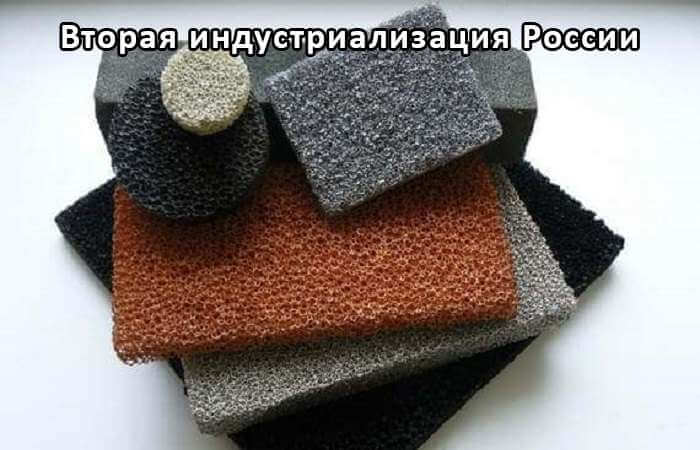Foam – a new class of materials of cellular structure

Foam – a new class of materials of cellular structure.
Foam – a new class of materials of cellular structure with extremely low density in combination with high specific strength, surface and sound absorption, low hydraulic resistance.
The main features and properties of foams
Description:
Foam – a new class of materials of cellular structure with extremely low density in combination with high specific strength, surface and sound absorption, low hydraulic resistance.
Currently, there are several fundamentally different ways to obtain foundry, a suspension (slip), chemical, electroplating, chemical vapor combinations. The main structural element is a cell, which is in the form of an elongated pentagonal rotational ellipsoid.
The internal structure, strength and hydraulic characteristics are determined primarily by the parameters the structure of the original matrix, porosity and relative density. Depending on the production method, material type, characteristics of technological regimes have foam there are differences in the microstructure of the matrix, jumper. In place of the removed matrix (except expanded metals obtained by casting) saved channel porosity. The volume of a triangular channel pore is 2-3% of the total volume of the material, and they account for three-dimensional connected network penetrating the entire sample.
Foams can be manufactured from different base materials: Nickel, copper, iron, nichrome, aluminum, resistant, chromal, stainless steel and alloys, bronze, Monel, cobalt, rhodium, platinum, gold, silver, carbon, porcelain, ceramic compositions (oxides, carbides, nitrides, borides, silicides).
This class of materials finds a variety of applications. At the same time for a wide range of potential customers they are still little known.
The main features and properties of foams:
– mesh-mesh structure,
– the foam has a high value connecting the open porosity of 80 to 97 %,
channel porosity,
– the foam has a large ratio of the elastic modulus and strength-to-density
– vibration,
– high connectivity of elements
– uniform energy absorption during deformation,
– the foam has a high permeability,
– small hydraulic resistance,
– the lack of end-to-end optical channels,
– intensive mass – and heat exchange with material flowing through the environment
– several mechanisms of heat transfer inside the material structure.
Properties of foams:
| Composition | Nickel | Copper | Nichrome | Aluminium | Ferronickel | Aluminium oxide | Silicon carbide | Zirconium oxide | |
| Ni 99.9% of | Cu 99,5-99,9% | Ni 75%, Cr 25% | Al 96%, Si 4% | Ni 5-80%, Fe – East. | Al2O3 98%, CA, K, Cr | Si 66 %, C 34 % | ZrO2 | ||
| Плотность1, g/cm3 | min. | 0,35 | 0,4 | 0,4 | 0,16 | 0,15 | 0,2 | ||
| max. | 0,7 | 0,8 | 0,6 | 0,4 | 0,45 | 0,8 | |||
| Porosity, % | min. | 85 | 85 | 90 | 88 | 90 | 80 | ||
| max. | 97 | 98 | 95 | 97 | 98 | 95 | |||
| Module Юнга2, GPA | min. | 0,4 | 0,17 | 0,06 | |||||
| max. | 1 | 0,37 | 0,3 | 2,8 | |||||
| Poisson’s Ratio | min. | 0,32 | |||||||
| max. | 0,34 | ||||||||
| Melting point, °C | 1445 | 1080 | 1400 | 660 | 3500 | ||||
| Temperature применения3 (including air), °C | 650 (450) | 250 (100) | 800 | 250 (140) | 400 | 1350 | 1500 | 1700 | |
| Теплопроводность4, W/m×K | 3 | 15 | 7 | 0,04 | |||||
1. the Density depends on the production technology, composition, and porosity.
2 the Estimated response data are shown for reference.
3 the Estimated response data are shown for reference. Temperature range of application significantly depends on the production technology, composition, corrosive environment.
4 the Estimated response data are shown for reference and reflect the conductivity of the matrix material, without taking into account convective and radiation heat transfer through the pores.
Application:
| Scope | Product, device, process | Used properties |
| Catalysis | Block elements are catalysts, catalysts | High specific surface area, permeability, heat resistance, strength |
| Filtering | Various filter elements (gases, liquids, melts metal) | Low hydrocortisone, advanced surface, thermal and durability in active media |
| Rechargeable items | Electric batteries high-capacity | High open porosity, conductivity |
| Acoustics | Sound-absorbing panels, elements of acoustic systems, extinguishers, acoustic absorbers with the high pressure relief | The structure of the pore space, thermal and vibration resistance |
| The composite structure | Ultra-light and heat-resistant structural elements, three – and two-layer panels, composite materials | Large ratio of the modulus of elasticity and strength to density, stiffness, low density, compatibility with the materials of the shells and fillers |
| The alignment of the gas and liquid flows | Wind tunnels, test stands, pressure sensors, mixing and separation of gases and liquids, filters | Low hydrocortisone, the uniformity of the pore structure (laminarinase – calm) |
| Heat exchangers and heat sink device | Compact heat exchangers, heat sink elements, partitioning | The structure of the pore space, the thermal conductivity of the foundations, low hydrocortisone |
| Electrolysis | Electrolysis of water solutions, electro-polishing, extraction of metal ions, the electrode for electrolysis | High specific surface area, permeability, conductivity, strength, corrosion resistance |
| Damping of mechanical pulses | Cumulative charges, the damper waves from surface ships, the energy absorber in the system security car | Pore structure, hardness, porosity, ability to deform at a constant low voltage energy absorbing |
| The fire and trivopaedia | Partition pipelines, mixers, exhaust pipe | Gas permeability, high communicating porosity |
| Condensation by-products | The device for separation of gas and condensed phases | High permeability, chemical stability, wettability |
| Fuel cells (direct methanol, polymer electrolytic, etc.) | The susceptor | High specific surface area, |
| The heating device | Heating elements, heaters, gases, liquids, evaporators, gas injectors, fuel catalysers | High gas permeability, electrical conductivity, thermal stability, interconnecting porosity |
| Shielding, absorption of electro-magnetic waves | Shielding elements in pulsed sources of electromagnetic fields, the technology “stealth” | Small density, structure of pore space |
| Biotechnology | Platform for growing biologically active systems | High porosity, specific surface, chemical resistance |



